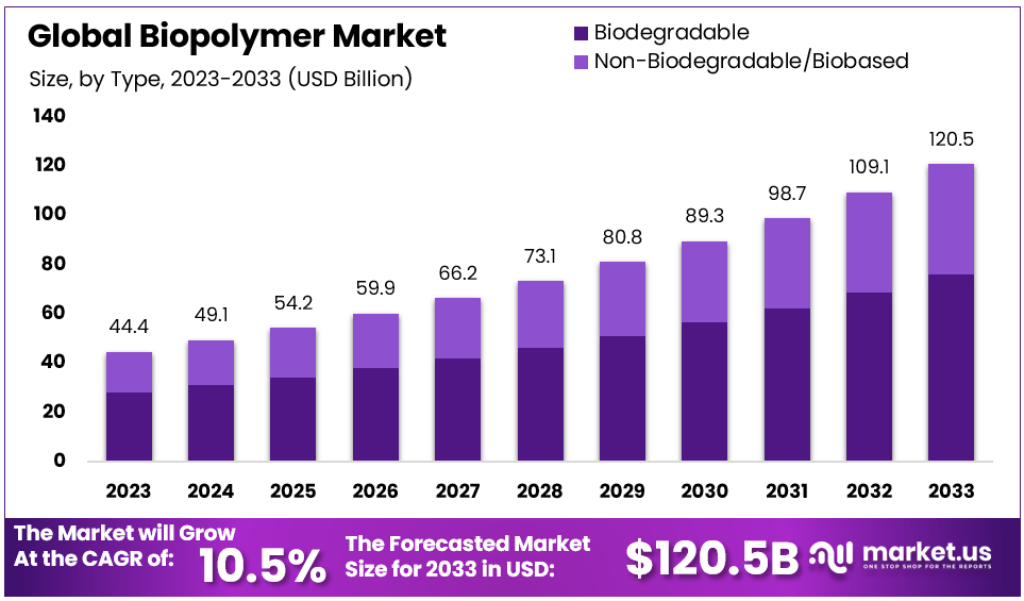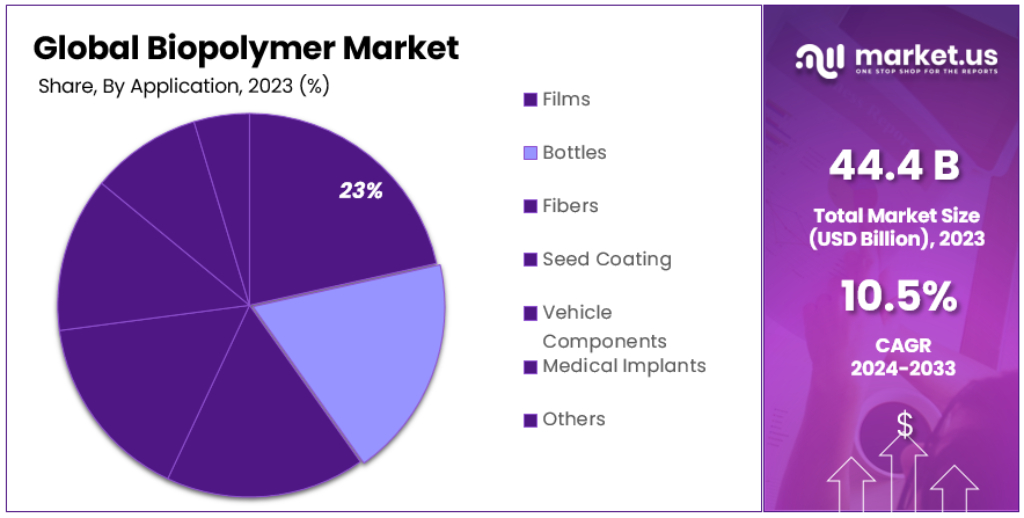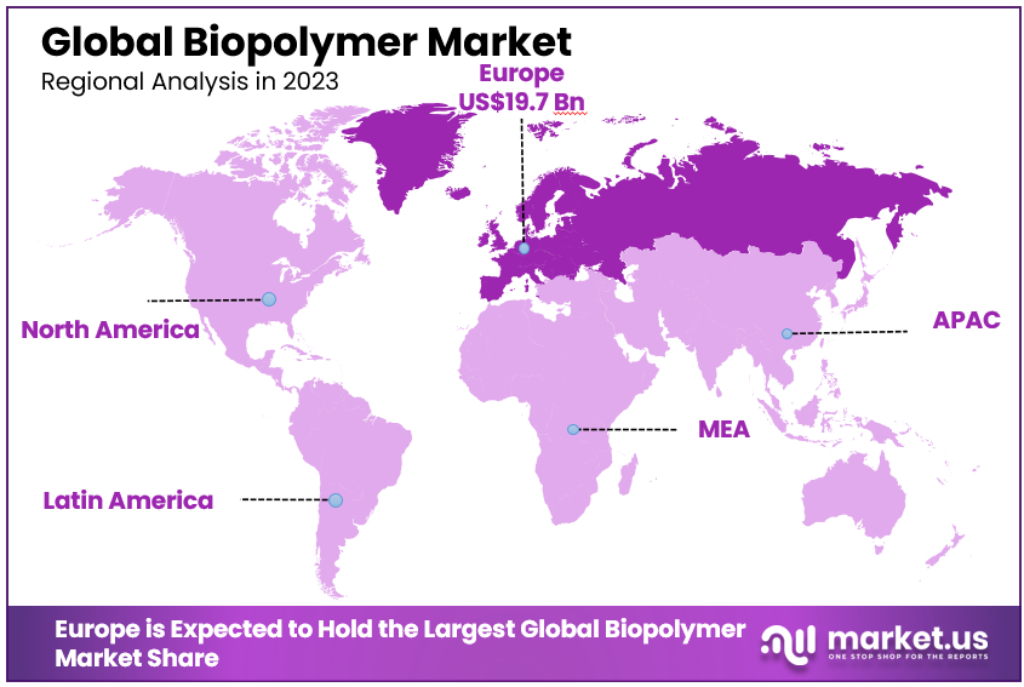New York, Jan. 24, 2024 (GLOBE NEWSWIRE) -- According to Market.us, The Global Biopolymer Market size is expected to be worth around USD 120.5 Billion by 2033, from USD 44.4 Billion in 2023, growing at a CAGR of 10.5% during the forecast period from 2024 to 2033.
The biopolymer market refers to the industry segment focused on developing, producing, and distributing biopolymers. Biopolymers are a type of polymer derived from biological sources, which includes living organisms or their by-products. Unlike traditional polymers, which are typically derived from petrochemicals, biopolymers are made from renewable sources such as plants, sugars, and microorganisms.
The biopolymer market encompasses a range of products, including bioplastics like polylactic acid (PLA), polyhydroxyalkanoates (PHA), and bio-based polyethylene (bio-PE), among others. These biopolymers find applications in various industries, including packaging, agriculture, automotive, and biomedical, owing to their properties like biocompatibility, mechanical strength, and reduced carbon footprint.
Request Sample Report and Drive Impactful Decisions: https://market.us/report/biopolymer-market/request-sample/

The market for biopolymers is driven by factors such as increasing environmental awareness, supportive government policies promoting green materials, advancements in biotechnology, and the rising demand for sustainable packaging solutions. The growth of the market can be attributed to these factors, along with the ongoing research and development efforts to enhance the properties and reduce the production costs of biopolymers.
Key Statistics
- The Biopolymer Market is projected to reach approximately USD 120.5 billion by 2033, showing significant growth from USD 44.4 billion in 2023.
- The market is expected to experience a CAGR of 10.5% during the forecast period from 2024 to 2033.
- In 2023, the Biodegradable segment held a dominant market position, capturing over 63.1% market share.
- Films, made from biopolymers, held a dominant market position in 2023, with over 23.3% market share.
- Europe maintained its dominance in the Biopolymer Market in 2023, accounting for a significant 44.5% share, with USD 19.7 Billion.
Factors Affecting the Growth of the Biopolymer Market
- Environmental Awareness and Consumer Demand: An increased global awareness of environmental issues, such as plastic pollution and climate change, has led to a growing demand for sustainable and eco-friendly products. This shift in consumer preferences is a significant driver for the biopolymer market, as more consumers and businesses seek alternatives to traditional, petroleum-based plastics.
- Technological Advancements: The development and refinement of technologies for the production and processing of biopolymers significantly impact market growth. Advances in biotechnology, material science, and industrial processing have enabled the production of biopolymers with improved properties and cost-effectiveness, making them more competitive with conventional plastics.
- Government Policies and Regulations: Governmental policies play a crucial role in shaping the biopolymer market. Regulations that limit the use of non-biodegradable plastics, along with incentives for sustainable packaging solutions, can significantly boost the demand for biopolymers. Furthermore, subsidies and support for research and development in this sector can accelerate market growth.
- Availability of Raw Materials: The biopolymer market depends on the availability of renewable biological resources, such as corn, sugarcane, and cellulose. The availability and price volatility of these raw materials can impact the cost of production and, consequently, the market growth.
- Economic Factors: The overall economic environment, including aspects like investment in green technologies, consumer spending power, and the economic viability of biopolymer production, influences market growth. The cost competitiveness of biopolymers compared to traditional plastics is a critical factor in determining their market adoption.
Buy Now this Premium Report to Grow your Business: https://market.us/purchase-report/?report_id=112340
Market Dynamics
Drivers
The environmental impact of traditional plastics is a key driver for the growth of the biopolymer market. Growing awareness of the detrimental effects of petrochemical-based plastics, which can leach harmful compounds into food and beverages, is prompting a shift towards biopolymers. These natural, safer alternatives align with increasing consumer and commercial demand for healthier materials. Additionally, global sustainable packaging initiatives, including bans on single-use plastics, are reinforcing this trend.
Governments are advocating for eco-friendly packaging, thereby accelerating the adoption of biopolymers. Furthermore, the biodegradable nature of biopolymers is appealing to consumers, as these materials decompose much faster than conventional plastics, offering an environmentally responsible solution that addresses the pressing issue of plastic waste in landfills.
Opportunities
The biopolymer market is experiencing significant growth in new areas, particularly in packaging and agriculture, fueled by rising governmental sustainability initiatives and consumer demand. In packaging, biopolymers are increasingly used for products like food packaging trays, cutlery, and cups, reflecting a broader trend towards sustainable packaging options.
Additionally, in agriculture, the use of biodegradable mulch films is emerging as a notable market opportunity. The Asia-Pacific (APAC) region, especially, is showing potential for market growth, as evidenced by developments such as Total Corbion's PLA plant in Thailand and Indonesia's exploration of seaweed-based bioplastics. The abundance of bio-based feedstock and evolving environmental regulations in these regions are key factors driving this market expansion.
Challenges
The higher cost of biopolymers, compared to traditional polymers, remains a major hurdle in their market expansion. Currently, biodegradable plastics are priced between USD 2 to USD 6 per kilogram, whereas conventional plastics are typically priced between USD 1 to USD 2 per kilogram. This price gap is largely due to the increased expenses associated with research and development, as well as the production processes of biopolymers. This cost disparity is a significant factor limiting the widespread adoption and market penetration of biopolymers.
Trends
The biopolymers market is undergoing considerable innovation, particularly in the development of new materials like ‘eco-alloys’—a blend of biopolymers and traditional polymers that are entirely biodegradable. Government initiatives worldwide are driving the shift towards a circular economy, as seen in the European Commission's action plan and the EFSA's research, further catalyzing the market.
Additionally, the medical devices industry, notably in Canada where the market was valued at approximately USD 8.6 billion in 2020, is increasingly adopting biopolymers, indicating a growing demand in this sector. A significant advancement in the field is the innovation of thermoplastic starch, derived from carbohydrates and combined with polymers like PLA, leading to the creation of fully biodegradable products. These developments collectively underscore the dynamic and evolving nature of the biopolymers market.
Want to Access the Statistical Data and Graphs, Request PDF Sample @ https://market.us/report/biopolymer-market/request-sample/
Report Segmentation of Global Biopolymer Market
Type Analysis
In 2023, the Biodegradable segment dominated the Biopolymer Market, accounting for over 63.1% of the market share. This segment includes materials like Polylactic Acid (PLA), Starch Blends, Polyhydroxyalkanoates (PHA), and Polybutylene Succinate (PBS), chosen for their eco-friendly characteristics, such as natural decomposition and reduced reliance on fossil fuels.
PLA, derived from resources like corn starch or sugarcane, is widely used in packaging, agriculture, textiles, and biomedical sectors, notable for its biocompatibility and ease of processing. Starch blends are popular in food packaging and agriculture due to their cost-effectiveness. PHA is gaining importance in medical applications like sutures and drug delivery, while PBS is used in packaging, disposable goods, and agricultural films for its mechanical properties.
On the other hand, the Non-Biodegradable/Biobased segment, though smaller, is significant, encompassing materials like BIO-PET, BIO-PA, BIO-PE, and BIO-PTT. BIO-PET is used in packaging for its durability, BIO-PA in automotive and electronics for its strength and thermal stability, while BIO-PE and BIO-PTT are emerging for their potential in carbon footprint reduction across various industries.
Application Analysis
In 2023, the Films segment led the Biopolymer Market with a notable 23.3% share, favored for their reduced environmental impact and used extensively in packaging, agriculture, and consumer goods. Their market dominance is due to versatility, biodegradability, and rising demand for sustainable packaging.
Bottles made from biopolymers are also gaining popularity, especially in the beverage industry, for their renewable nature and lower carbon footprint. In the textiles, automotive, and industrial sectors, biopolymer-derived fibers are valued for their eco-friendliness, aligning with the growing demand for sustainable materials. Innovative applications like seed coatings in agriculture and vehicle components in the automotive industry are emerging, leveraging biopolymers for efficiency and reduced environmental impact.
Furthermore, medical implants represent a vital application, with biodegradable polymers being increasingly used for temporary implants and drug delivery systems. In 2023, the Biopolymer Market, across these application segments, achieved a valuation of USD 44.4 billion and is projected to grow at a CAGR of 10.5% from 2024 to 2033.

End User Analysis
In 2023, the Packaging end-user segment dominated the Biopolymer Market with a 53.3% share, reflecting a growing demand driven by environmental regulations and changing consumer lifestyles. This segment's use of bioplastics and biopolymers in applications like food, healthcare, cosmetics, and shopping bags stems from their high strength and water impermeability, making them suitable for product protection. While packaging remains a major application area, the quality of biopolymer-based products may not always match that of traditional plastics.
Food and beverage packaging is a significant sub-segment, favored for the material's strength, light weight, and heat resistance. Additionally, the Automotive and transportation segment is integrating biopolymers to reduce vehicle weight and environmental impact. In Textiles, biopolymers are used in medical textiles, personal care products, and clothing, driven by the demand for sustainable materials. The Agriculture and horticulture sector is also adopting biopolymers, particularly in tapes and mulch films, aligning with a shift towards sustainable agricultural practices.
Key Market Segments
By Type
- Biodegradable
- PLA
- Starch Blends
- PHA
- PBS
- Others
- Non-Biodegradable/Biobased
- BIO-PET
- BIO-PABIO-PE
- BIO-PTT
- Others
By Application
- Films
- Bottles
- Fibers
- Seed Coating
- Vehicle Components
- Medical Implants
- Others
By End User
- Packaging
- Rigid Packaging
- Flexible Packaging
- Consumer Goods
- Electrical Appliances
- Domestic Appliances
- Others
- Automotive & Transportation
- Interior
- Exterior
- Under Hood
- Textiles
- Medical & Healthcare Textile
- Personal care, clothes and other textiles
- Agriculture & Horticulture
- Tapes & Mulch Films
- Others
- Others
Competitive Landscape
The competitive landscape of the market has also been examined in this report. Some of the major players include:
- Nature Works
- Braskem
- BASF
- Total Corbion
- Novamont
- Biome Bioplastics
- Mitsubishi Chemical Holding Corporation
- Biotec
- Toray Industries
- Plantic Technologies
- Other Market Players
Scope of the Report
| Report Attributes | Details |
| Market Value (2023) | US$ 44.4 Billion |
| Forecast Revenue 2033 | US$ 120.5 billion |
| CAGR (2024 to 2033) | 10.5% |
| Europe Revenue Share | 44.5% |
| Base Year | 2023 |
| Historic Period | 2018 to 2022 |
| Forecast Year | 2024 to 2033 |
Regional Analysis
In 2023, Europe led the Biopolymer Market with a 44.5% share, amounting to USD 19.7 billion, driven by strict environmental regulations and a shift towards bio-based products. The region's market growth is fueled by the increasing use of plastics and heightened awareness of bio-based alternatives, particularly in the food and beverage industry, which saw an 8.2% production increase in 2020.
Meanwhile, the Asia-Pacific region is projected to experience the highest growth rate, spurred by government plastic bag bans, global warming initiatives, and a rising preference for eco-friendly products. Despite the higher cost of bioplastics, the Asia-Pacific market, including China, Japan, and India, is rapidly adopting biopolymers in various industries. Europe's market strength is anticipated to continue, bolstered by EU directives against plastic bags and the promotion of recyclable packaging.
France's ban on standard plastic bags for fruits and vegetables is a case in point. Overall, the global biopolymers market is shaped by environmental concerns, government policies, and technological advancements, with key market players like Plantic Technologies Ltd, BASF SE, and Novamont SpA driving growth through innovation. Europe's environmental laws and Asia Pacific's focus on sustainability and industrial growth are crucial in determining the market's global dynamics.

By Geography
- North America
- The US
- Canada
- Europe
- Germany
- France
- The UK
- Spain
- Italy
- Russia
- Netherland
- Rest of Europe
- APAC
- China
- Japan
- South Korea
- India
- Australia
- New Zealand
- Singapore
- Thailand
- Vietnam
- Rest of APAC
- Latin America
- Brazil
- Mexico
- Rest of Latin America
- Middle East & Africa
- South Africa
- Saudi Arabia
- UAE
- Rest of MEA
Explore More Chemicals & Materials Market Research Reports
- Recycled Plastics Market size is expected to be worth around USD 114.8 billion by 2033, from USD 52.7 billion in 2023, growing at a CAGR of 8.1% during the forecast period from 2023 to 2033.
- Caustic Soda Market size is expected to be worth around USD 73.4 Bn by 2032 from USD 4.48 Bn in 2022, growing at a CAGR of 5.2% during the forecast period from 2022 to 2032.
- Silico Manganese Market size is expected to be worth around USD 40.05 Bn by 2032 from USD 23.76 Bn in 2022, growing at a CAGR of 5.5% during the forecast period from 2022 to 2032.
- zeolite market was valued at USD 8.5 billion and is expected to be valued at USD 12.7 billion by 2032. Between 2023 and 2032 this market is estimated to register the highest CAGR of 4.2%.
- Plant-Based Meat Market size was valued at USD 6.7 billion and will reach USD 35.1 billion by 2032. Between 2023 and 2032, this market is estimated to register the highest CAGR of 18.5%.
- Activated Carbon Market size is expected to be worth around USD 5.4 billion by 2032 from USD 3.6 billion in 2022, growing at a CAGR of 4.2% during the forecast period 2023 to 2032.
- flexible Packaging market size is predicted to reach USD 385.2 billion in 2033 up or down from USD 236.5 billion by 2023 and growing by a CAGR of 5.0% over the period between 2023 and 2033.
- Ceramic Tile Market is anticipated to be USD 583.6 billion by 2033. It is estimated to record a steady CAGR of 6.8% in the Forecast period 2023 to 2033. It is likely to total USD 302.3 billion in 2023.
- Graphene Market size is expected to be worth around USD 62 billion by 2033 from USD 2 billion in 2023, growing at a CAGR of 42.5% during the forecast period from 2023 to 2033.
- Ammonia Market size was valued at USD 70.4 Billion. This market is estimated to reach USD 134.9 Billion in 2032 At a CAGR of 6.9% between 2023 and 2032.
About Us
Market.US (Powered by Prudour Pvt Ltd) specializes in in-depth market research and analysis and has been proving its mettle as a consulting and customized market research company, apart from being a much sought-after syndicated market research report-providing firm. Market.US provides customization to suit any specific or unique requirement and tailor-makes reports as per request. We go beyond boundaries to take analytics, analysis, study, and outlook to newer heights and broader horizons.
Follow Us On LinkedIn Facebook Twitter
Our Blog:
